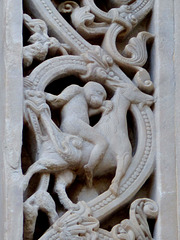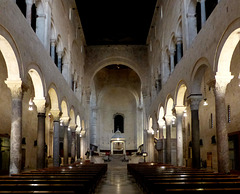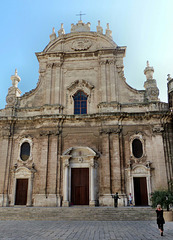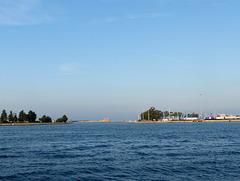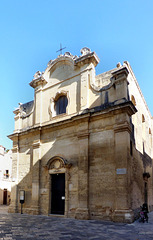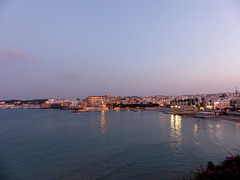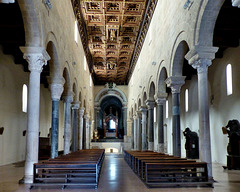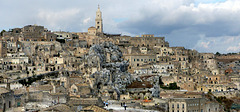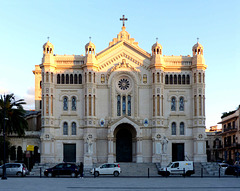
Italy
Photos taken in Italy (and Vatican State and San Marino).
Bari - Cattedrale di San Sabino
| |
|
|
Bari was an early settlement and passed under Roman rule in the 3rd century BC. It developed strategic significance as the point of junction between the coast road and the Via Traiana and as a port for eastward trade. The first bishop of Bari was Gervasius who is known from the Council of Sardica in 347.
After the decline of the Roman Empire, the town was devasted and taken by Alaric´s Visigothic troops, then was under Lombardian rule, before the Byzantines took over. In 755 it was conquered by Pepin the Short (Charlemagne´s father) and from 847 on it was an Islamic Emirate. The Byzantine fleet returned in 871 and since 885 Bari ws the residence of the local Byzantine governor.
Following a three-year siege, Bari was captured by Robert Guiscard in 1071. After the relics of Saint Nicholas, which were surreptitiously brought from Myra in Lycia (Byzantine territory), arrived in Bari, the Basilica di San Nicola was founded in 1087. This attracted pilgrims, whose encouragement and care became central to the economy of Bari. Pope Urban II consecrated the Basilica in 1089. In 1096 a crusader army embarked in the port of Bari for the First Crusade.
After the murder of archbishop Griso in 1117 a civil war broke our and the control was seized by Grimoald Alferanites, a native Lombard, in opposition to the Normans. He later did homage to Roger II of Sicily, but rebelled and was defeated in 1132.
The Castello Normanno-Svevo (aka "Castello di Bari") was probably built around 1132 by Norman King Roger II. When in 1155 the Baresi rebelled against the Normans, the castle got destroyed, so as a retaliatory action, William I of Sicily (aka William the Wicked") had the city destroyed except for the cathedral and the Basilica of St. Nicola.
Bari recovered and had its heydays under Frederick II. When he returned from his crusade after 1229, the city gates were locked so he had to use force to gain entry. Therefore, he probably had the fort built in 1233 to keep the city in check. On the other hand, he granted the city generous trade privileges and left it the leading role in the region.
-
The construction of the "Cattedrale di San Sabino" (aka "Bari Cathedral" started around 1170 on. The cathedral is the seat of the Archbishop of Bari-Bitonto. It is dedicated to Saint Sabinus, a bishop of Canosa, whose relics were brought here in the 9th century.
It was erected on the site of the ruins of the Imperial Byzantine cathedral, destroyed in 1156 by William I of Sicily with the rest of the city.
For the reconstruction of the cathedral materials from the preceding church and other destroyed buildings got reused. During the 18th century the façade, the nave and aisles and the crypt were refurbished in Baroque style. The building later underwent a series of refurbishments, demolitions and extensions.
The apse window is a masterpiece of the Apulian Romanesque style of the late 12th century.
Below the window sill is a relief depicting two peacocks within tendrils. To the left end right, supporting the columns are two elephants. They are rather small. Pina Belli D'Elia ("Puglia Romanica") compares them to chess pieces. On top of the columns are two monsters (a male and a female) with human faces, wings, claws and snake tails. They support the outer archivolt. On top of this is another monster that may be a beheaded sphinx holding its head, mouth wide open. The smaller inner archivolts are masterly carved and are populated with lots of animals and mythical creatures floating in vines, like this monkey, riding a goat.
Bari - Cattedrale di San Sabino
| |
|
|
Bari was an early settlement and passed under Roman rule in the 3rd century BC. It developed strategic significance as the point of junction between the coast road and the Via Traiana and as a port for eastward trade. The first bishop of Bari was Gervasius who is known from the Council of Sardica in 347.
After the decline of the Roman Empire, the town was devasted and taken by Alaric´s Visigothic troops, then was under Lombardian rule, before the Byzantines took over. In 755 it was conquered by Pepin the Short (Charlemagne´s father) and from 847 on it was an Islamic Emirate. The Byzantine fleet returned in 871 and since 885 Bari ws the residence of the local Byzantine governor.
Following a three-year siege, Bari was captured by Robert Guiscard in 1071. After the relics of Saint Nicholas, which were surreptitiously brought from Myra in Lycia (Byzantine territory), arrived in Bari, the Basilica di San Nicola was founded in 1087. This attracted pilgrims, whose encouragement and care became central to the economy of Bari. Pope Urban II consecrated the Basilica in 1089. In 1096 a crusader army embarked in the port of Bari for the First Crusade.
After the murder of archbishop Griso in 1117 a civil war broke our and the control was seized by Grimoald Alferanites, a native Lombard, in opposition to the Normans. He later did homage to Roger II of Sicily, but rebelled and was defeated in 1132.
The Castello Normanno-Svevo (aka "Castello di Bari") was probably built around 1132 by Norman King Roger II. When in 1155 the Baresi rebelled against the Normans, the castle got destroyed, so as a retaliatory action, William I of Sicily (aka William the Wicked") had the city destroyed except for the cathedral and the Basilica of St. Nicola.
Bari recovered and had its heydays under Frederick II. When he returned from his crusade after 1229, the city gates were locked so he had to use force to gain entry. Therefore, he probably had the fort built in 1233 to keep the city in check. On the other hand, he granted the city generous trade privileges and left it the leading role in the region.
-
The construction of the "Cattedrale di San Sabino" (aka "Bari Cathedral" started around 1170 on. The cathedral is the seat of the Archbishop of Bari-Bitonto. It is dedicated to Saint Sabinus, a bishop of Canosa, whose relics were brought here in the 9th century.
It was erected on the site of the ruins of the Imperial Byzantine cathedral, destroyed in 1156 by William I of Sicily with the rest of the city.
For the reconstruction of the cathedral materials from the preceding church and other destroyed buildings got reused. During the 18th century the façade, the nave and aisles and the crypt were refurbished in Baroque style. The building later underwent a series of refurbishments, demolitions and extensions. The original Romanesque appearance of the interior was restored in the 1950s.
The nave is 34 metres long. See at the end is the ciborium.
Monopoli - Concattedrale della Madonna della Madia
| |
|
Monopoli, located about 50kms south of Bari, was founded by Greek settlers. During the Roman Empire, it was connected to the Via Traiana. When the neighbouring Gnathia (Egnatia) was destroyed by the troops of the Ostrogoth king Totila in 545, its inhabitants fled to Monopoli, which from then on lived up to its meaning as the “only city” (literal translation of the city's name).
In the following centuries, the area was ruled by Normans, Byzantines, Staufers, Venetians, Spaniards, Habsburgs and Bourbons. In 1860 Monopoli, like the Kingdom of the Two Sicilies, was annexed to the Kingdom of Italy.
-
Archaeological excavations started in 1986 revealed here an area of ancient and complex temporal stratifications that, starting from about 4500 BC, reach up to the present day.
The Romanesque cathedral of Monopoli was built by demolishing a previous church of the early Christian age, built around 250 AD on the ruins of a Roman temple. The erection started with the support of Norman duke Robert de Hauteville in the 12th century but the works were soon interrupted due to the lack of material for the construction of the roof. According to tradition, in December 1117 a raft landed in the port of the city carrying the icon of the Madonna della Madia. The raft beams were used to erect the roof, but it took up to 1442 to complete the church. It had three belltowers of which two got damaged during a siege in 1528. The remaining tower collapsed in 1686, killing forty people.
In the early 18th century, the meanwhile dilapidated Romanesque basilica got demolished to replace it by a large, spacious one in Baroque style. Work began in 1742 and was completed in 1772.
Brindisi - Castello alfonsino
| |
|
|
Settlers, who did trade with Greece, lived here already during the Bronze Age. After the Punic Wars it became a major center of Roman naval power and maritime trade. After the decline of the Roman Empire Brindisi was conquered by Ostrogoths, and reconquered by the Byzantine Empire in the 6th century. In 674 it was destroyed by the Lombards led by Romuald I of Benevento, It was rebuilt and within the 9th century. It was under Saracen rule from 836 to 868, when it was retaken by the Byantines. In 1070, it was conquered by the Normans, led by Robert Guiskard.
Brindisi flourished under the Staufer and developed into a privileged port for the Holy Land during the period of Crusades. It was an Episcopal See and a new cathedral was constructed, in which the wedding of Norman Prince Roger III of Sicily and Irene Angelina, daughter of the Byzantine Emperor Isaac II Angelos took place. Emperor Frederick II and Isabella of Brienne embarked from the port of Brindisi in 1228 for the Sixth Crusade.
-
Brindisi has this fine natural harbour, an inlet that runs deep into the Adriatic coast. The harbour was already used by the first settlers. It was very important for the Roman Empire and in the times of crusades one of the main ports in Southern Italy.
Seen in the distance is the "Castello alfonsino", securing the entrance of the "inner harbour". Already in the 11th century, a Benedictine abbey existed on the island that was later abandoned. So in the 14th and 16th century the "Forte a Mare" was erected.
Lecce - San Niccolò dei Greci
| |
|
|
A legend tells, that a city called Sybar existed at the time of the Trojan War. It was conquered by the Romans in the 3rd century BC, receiving the new name of Lupiae.
After the fall of the Western Roman Empire, Lecce was sacked by the Ostrogoth troops of king Totila. In 549 it was taken by Byzantium and remained part of the Eastern Roman Empire for five centuries, interrupted by brief invasions by the Saracens, Longobards, Hungarians and Slavs.
After the Norman conquest in the 11th century, Lecce regained commercial and political importance, flourishing in the subsequent Hohenstaufen and Angevine rule. From the 15th century, Lecce was one of the most important cities of southern Italy, and, starting in 1630, it developed into a centre of Baroque architecture. This was made possible by the soft tuff stone found in the area, perfect for that architecture.
-
Form the end of the 15th century, pushed by Ottoman persecution, a strong migration of Albanians to Southern Italy took place. The Albanians in Italy had built new communities and had created a community, with its own Byzantine rite, in Lecce. Over centuries their church was used by the Greek and Albanian merchants residing in Lecce,
In 1765 San Niccolò dei Greci was built in a late Baroque style. It incorporates the remains of a Romanesque church.
Lecce - Duomo di Lecce
| |
|
|
A legend tells, that a city called Sybar existed at the time of the Trojan War. It was conquered by the Romans in the 3rd century BC, receiving the new name of Lupiae.
After the fall of the Western Roman Empire, Lecce was sacked by the Ostrogoth troops of king Totila. In 549 it was taken by Byzantium and remained part of the Eastern Roman Empire for five centuries, interrupted by brief invasions by the Saracens, Longobards, Hungarians and Slavs.
After the Norman conquest in the 11th century, Lecce regained commercial and political importance, flourishing in the subsequent Hohenstaufen and Angevine rule. From the 15th century, Lecce was one of the most important cities of southern Italy, and, starting in 1630, it developed into a centre of Baroque architecture. This was made possible by the soft tuff stone found in the area, perfect for that architecture.
-
The cathedral is located on the southeast corner of the "Piazza del Duomo" in the centre of the city. It first built in 1144, it underwent modifications later and was rebuilt in 1659 by the architect Giuseppe Zimbalo (aka "Zingarello") by order of bishop Luigi Pappacoda, in thy Baroque style typical for Lecce. The architect did not change the general layout but added an enormous, Baroque portal. This portal is considered to be a masterpiece of Baroque art.
The campanile was built between 1661 and 1682. It was built to replace the Romanesque one, which had collapsed at the beginning of the 17th century. At a height of about 70 m the bell tower offers views of the Adriatic Sea and was used as a watchtower in former times.
Otranto
| |
|
|
Otranto occupies the site of an ancient Greek city. It gained importance in Roman times, as it was the nearest port to the eastern coast of the Adriatic Sea.
After the end of the Roman Empire, it was in the hands of the Byzantine emperors until it surrendered to the Norman troops of Robert Guiscard in 1068. The Normans fortified the city and built the cathedral, that got consecrated in 1088. When Henry VI., son of Emperor Frederick Barbarossa, married Constanze of Sicily in 1186 Otranto came under the rule of the Hohenstaufen and later in the hands of Ferdinand I of Aragón, King of Naples.
Between 1480 and 1481 the "Ottoman invasion" took place here. Troops of the Ottoman Empire invaded and laid siege to the city and its citadel. Legends tell that more than 800 inhabitants were beheaded after the city was captured. The "Martyrs of Otranto" are still celebrated in Italy, their skulls are on display in the cathedral. A year later the Ottoman garrison surrendered the city following a siege by Christian forces and the intervention of Papal forces.
Taranto - Cattedrale di San Cataldo
| |
|
Taranto located on a peninsula was founded by Greek settlers and during the period of Greek colonization in Southern Italy, the city was among the most important in "Magna Graecia". During the Second Punic War, Taranto supported Hannibal in Italy and opened it´s doors to his troops in 212 BC, but when Romans recaptured Taranto three years later, they massacred the citizens and looted the town. It became a Roman colony later.
After the fall of the Roman Empire, Taranto got fortified. In 547 Taranto asked a Byzantine general for support. He greatly reduced the size of the city in order to be able to defend it. So he separated the part of the isthmus from the actual city area, making an island out of the peninsula and fortified it strongly. Nevertheless, three years later, the city was conquered by the Ostrogoth troops of Totila. Later Taranto was ruled by Langobards. The city was conquered by the Saracens in 839 and an emirate existed up to 880 when it was taken by a Byzantine army, but in 927 the Saracens were back looted and destroyed the city. It was rebuilt under Byzantine power from 967 on. Normans conquered Taranto in the second half of the 11th century and founded the "Principality of Taranto" 1086, later bequeathed by Frederic II to his son Manfred.
The Old Town ("Città Vecchia") still retains the same street layout of 967, when the Byzantines rebuilt it after Saracen troops had razed to the ground in 927. Still in 1746 the entire population of Taranto resided in Old Town. By 2013 the population of the Old Town was just 1000 while the wider city had more than 200000 inhabitants. Today the structural structure of the old town in this area is currently in a disastrous state. Many houses are abandoned, in danger of collapsing or already in ruins. The old town today is a drastic example of an urban state of neglect.
The Taranto Cathedral is located in the centre of the old town in a place, where the Greek settlers had a temple already. The construction of the church was started in the second half of the 10th century by the Byzantines during the reconstruction of the city. End of the 11th century the Byzantine structure was remodelled and enlarged by Norman builders. The current cathedral, dedicated Saint Cataldo, an Irish monk, who became bishop here in the 7th century, was built, "reusing" large parts of the Byzantine building and so creating a Romanesque basilica on a Latin Cross.
The cathedral measures 84 meters in length and 24 in width, has a central nave, two side aisles and a transept. The nave and the aisles are divided by a double series of eight columns surmounted by differently made capitals, some of which have been reused from ancient buildings no longer in use.
The original ceiling was destroyed by a fire on Christmas night in 1635. The current one was completed in 1713. It is made up of forty-eight panels between which two wooden statues depicting San Cataldo and Maria Immacolata are set.
Matera - Sasso Caveoso
| |
|
|
|
The original settlement of Matera lies in two canyons carved by the Gravina River. This area, the Sassi di Matera, is a complex of cave dwellings carved into the ancient river canyon. The settlement is divided into the districts of Sasso Barisano and Sasso Caveoso.
The cave settlements in the area are an exceptional example in the Mediterranean area. Inhabited since the Neolithic Age, Matera can be considered one of the oldest cities in the world.
According to Greek, Roman, Langobard and Byzantine history, which Matera shares with all of southern Italy, Saracens devastated the place in 938. It came under Norman rule in 1043, became a royal seat and thus achieved considerable wealth. This bloom continued under the subsequent regiments of the Staufer and Anjou, in 1270 the cathedral of Matera was completed.
Already by the late 1800s, Matera's cave dwellings became noted for intractable poverty, poor sanitation, meager working conditions, and rampant disease. In 1948, when the city was hit by malaria, 15,000 people lived in 3,300 rooms. From the 1950s on the residents were relocated to newly built apartment blocks. Since the Sassi are now a museum town, tourism is also becoming increasingly important.
Known as la città sotterranea ("the underground city"), the Sassi and the park of the Rupestrian Churches were named a UNESCO World Heritage Site in 1993. In 2019, Matera was declared a European Capital of Culture.
Matera - Convento di Sant'Agostino
| |
|
|
The original settlement of Matera lies in two canyons carved by the Gravina River. This area, the Sassi di Matera, is a complex of cave dwellings carved into the ancient river canyon. The settlement is divided into the districts of Sasso Barisano and Sasso Caveoso.
The cave settlements in the area are an exceptional example in the Mediterranean area. Inhabited since the Neolithic Age, Matera can be considered one of the oldest cities in the world.
According to Greek, Roman, Langobard and Byzantine history, which Matera shares with all of southern Italy, Saracens devastated the place in 938. It came under Norman rule in 1043, became a royal seat and thus achieved considerable wealth. This bloom continued under the subsequent regiments of the Staufer and Anjou, in 1270 the cathedral of Matera was completed.
Already by the late 1800s, Matera's cave dwellings became noted for intractable poverty, poor sanitation, meager working conditions, and rampant disease. In 1948, when the city was hit by malaria, 15,000 people lived in 3,300 rooms. From the 1950s on the residents were relocated to newly built apartment blocks. Since the Sassi are now a museum town, tourism is also becoming increasingly important.
Known as la città sotterranea ("the underground city"), the Sassi and the park of the Rupestrian Churches were named a UNESCO World Heritage Site in 1993. In 2019, Matera was declared a European Capital of Culture.
The complex was built in 1592 for the Order of Saint Augustine ("Emeritani di Sant'Agostino") and is large and pretty for a mendicant order. The Baroque Church Santa Maria delle Grazie was added two years later. Destroyed in 1734 by an earthquake, the complex was restored and became the seat of the General Chapter of the Augustinian Order. Today it hosts the seat of the Superintendence for Architectural and Environmental Heritage.
The church was built over the preexisting rock church of San Giuliano, that can be entered from the nave of Santa Maria delle Grazie.
Reggio Calabria - Duomo di Reggio
| |
|
|
Reggio Calabria is the largest city in Calabria. It has an estimated population of nearly 200,000. Reggio is the oldest city in the region, and during ancient times, it was an important and flourishing colony of Magna Graecia. It is separated from the island of Sicily by the Strait of Messina. Today Reggio has a modern urban system, set up after the catastrophic earthquake of 1908, which destroyed most of the city. The seismicity is caused by Reggio being on the Eurasian Plate near the faultline where it meets the African Plate that runs through the strait, dividing the two European regions of Calabria and Sicily into two different tectonic regions.
Reggio, located opposite Messina, always had strategic importance. Invasions by the Vandals, the Lombards, and the Goths occurred in the 5th–6th centuries. Then, under Byzantine rule, it became a metropolis of Byzantine possessions in Italy. Until the 15th century, Reggio was one of the most important Greek-rite Bishoprics in Italy. The Arabs occupied Reggio in 918. For brief periods in the 10th–11th centuries, the city was ruled by the Arabs and it became part of the Emirate of Sicily. In 1005, a Christian fleet coming from Pisa sacked the city and massacred all the Saracens to the great jubilation of the local population. In 1060 the Normans, under Robert Guiscard and Roger I of Sicily, captured Reggio. In 1194 Reggio and the whole of southern Italy went to the Hohenstaufen, who held it until 1266. In 1234 the town fair was established by decree of King Frederick II.
The first church building was erected around 300 AD on the ruins of a Greek temple of Apollo. It was expanded and rebuilt over the centuries. Completely destroyed by the earthquake of 1908, the cathedral was rebuilt in the neo-Romanesque style. The Cathedral was consecrated in 1928.
Jump to top
RSS feed- Latest items - Subscribe to the latest items added to this album
- ipernity © 2007-2024
- Help & Contact
|
Club news
|
About ipernity
|
History |
ipernity Club & Prices |
Guide of good conduct
Donate | Group guidelines | Privacy policy | Terms of use | Statutes | In memoria -
Facebook
Twitter

